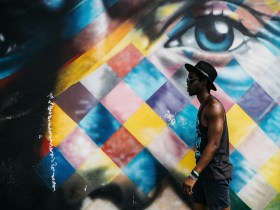Finissage at London’s Enclave
We may have grown tired of the elitism of the vernissage, but its counter point – the finissage – is growing traction as a way to maintain the hype.
Vernissage is a word synonymous with the art world. It describes the preview or private view of an art exhibition, biennale or art fair prior to the public free-for-all. It has long been the territory of the VIP list or the A-lister, and bolstering the perception of art world elitism.
While its origins are French, the term, like the art world itself, is international. The word vernissage – meaning varnishing -comes from 19th century art school vernacular, when students would varnish their artworks at the last minute before their graduating exhibition opened. It became the custom of patrons and the elite to visit the academies during the “varnishing day” – a tradition that took on a more commercial tone in the 20th century when it became a market opportunity for clients and collectors.
A term that has been coined more recently is its counterpoint – the Finissage. And you guessed it – the term is given to the closing party for an exhibition or art event. The difference being, this one is usually open to all. The focus has shifted from art market to marketing.
Event obsession
In the past, Australia hasn’t embraced these European terms with gusto but there has been a recent flurry to market the finissage. But the finissage is taking off in a big way. What is driving its sudden popularity?
The key is in the increasingly competitive marketplace faced by artists, arts organisations and events. In 2013, The Economist reported that there were ‘at least 55,000 museums across the world, more than double the number 20 years ago.’ And that is not counting the number of temporary, cyclical events such as biennales and art fairs that have mushroomed alongside this cultural infrastructure.
Competition has been accompanied by a new democratisation that makes the old style A-list vernissage less valuable than an event that draws varied audiences, spawned via new communication channels.
Social media builds hype around an event and has resulted in a changing relationship with cultural activity. Audiences rate ‘authentic experience’ as most desired. When everything is available online, the capacity of art to provide live, engaging experiences has a new value.
The thing that is selling now – and growing fast in the brand sector – is the experience. So the more experience you can package around an exhibition the greater its visibility and perceived success.
Read: Making your brand stick
Hanging a few paintings on the walls and opening the doors hardly cuts it these days. The exhibition cycle is jam-packed with talks, tours, workshops, digital engagement, kids activities, merchandising and specialising dining, patron events and parties.
Read: Museums struggle with entertainment imperative
Exhibitions and art events are expensive to produce and present, and organisations have been pushed deeper into the corner of accountability in recent years.
To squeeze those extra numbers out of an exhibition with a closing event or finissage weekend is a smart strategic marketing decision.





